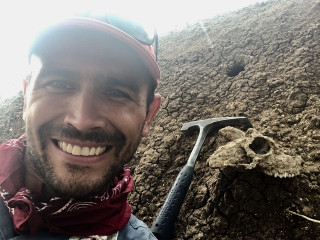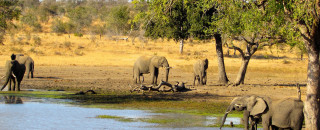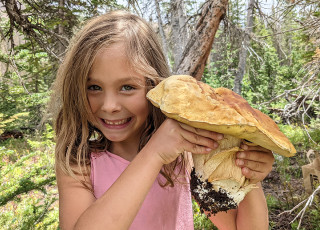How Environmental Shifts Killed Africa’s Prehistoric Megaherbivores
Elephants (Loxodonta africana) at a savanna watering hole in Africa. Photo courtesy of John Rowan.
By Brian Switek
Africa is home to some of the most fantastic beasts on the planet. Giraffes, hippos, rhinos, and elephants, for example, are the charismatic megaherbivores that make up critical plant-munching parts of many ecological communities. But this is only just a shadow of what existed in the ancient past.
At various times during the past 7 million years, up to 10 different megaherbivore species occupied the same habitats. (Zoologists classify megaherbivores as plant-eating species over 1,000 kilograms.) That’s double the diversity of such communities today. So what happened? Natural History Museum of Utah curator of anthropology Tyler Faith, in cooperation with colleagues, has just published a new study on why the megaherbivores of the deep past disappeared from Africa.
Up until now, Faith says, the blame for these losses has often rested on ancient humans. The hypothesis went something like this. Around 2 million years ago, with the origin of Homo erectus, our predecessors underwent a dramatic behavioral and cultural shift that included consuming a larger amount of animal protein. Humans entered the “carnivore guild” occupied by beasts like leopards and hyenas, no longer relying on scraps left behind by carnivores but acquiring fresh meat. A perceived decline in megaherbivore diversity around this time seemed to track with the altered eating habits of hungry hungry humans.

But no one systematically tested this idea. “These speculations eventually came to be accepted as fact by some,” Faith says, “even though we lacked detailed understanding of the timing and pace of megaherbivore diversity loss and its relationship to hominin evolution.” To that end, Faith and colleagues turned to modern and fossil data to understand how Africa’s megaherbivore communities have changed over the past 7 million years - or, since the time our ancestors became distinct from other apes on their own evolutionary lineage.
The fossil record tells a different story than what had previously been assumed. The decline in Africa’s megaherbivores didn’t occur once humans started including more meat in their diet but long before, around 4.6 million years ago. Humans were not consummate hunters during this time, but were more ape-like and consumed a greater amount of vegetation. Instead, environmental change appears to have been the key factor.
“The open grassland habitats that we often envision when we think of the Serengeti plains and other parts of eastern Africa did not exist a few million years ago,” Faith says. Instead, African habitats that were rich in megaherbivores - and their predators - often boasted more trees and shrubs. “We show that the loss of megaherbivore diversity corresponds with the long-term expansion of grassland habitats,” Faith says, which was driven by declining atmospheric carbon dioxide levels that gave an advantage to grasses.
These shifts trickled through ancient Africa’s ecology. Herbivores moved, adapted, or went extinct as the woodlands turned to grasslands. On top of that, the carnivores that relied on those herbivores - such as saber-toothed cats adapted to taking down large prey - felt the pressure. Human activity may have had some influence, but, Faith says, “Given that carnivore diversity and herbivore diversity are closely related today, it is very likely that the demise of megaherbivores over the last ~4.5 million years translated to the loss of some carnivores.”
This isn’t just about refining our understanding of the past, though. We live in a time of intense, human-driven climate change and ecosystem disruption, and what transpired in the deep past can help us anticipate how our present actions will play out. “Sorting out when people began to dominate the natural world can help us evaluate what sort of ecosystems we should aim to conserve or restore in the long term,” Faith says. What’s more, “The fossil record provides exciting opportunities to explore and tease apart the consequences of climatic and anthropogenic impacts over evolutionary time-scales, which in turn affords a better understanding of what future change should look like.” To plan for the future, we need to understand the past.
Brian Switek is the author of My Beloved Brontosaurus, Prehistoric Predators, and a science writer for the Natural History Museum of Utah, a part of the University of Utah in Salt Lake City. Our mission is to illuminate the natural world and the place of humans within it. In addition to housing outstanding exhibits for the public, NHMU is a research museum. Learn more.


